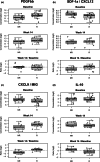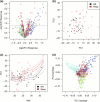Serum proteomic and metabolomic analyses from patients with IBD identify biological pathways associated with treatment success with anti-integrin therapy
- PMID: 40509637
- PMCID: PMC12354290
- DOI: 10.1111/imcb.70039
Serum proteomic and metabolomic analyses from patients with IBD identify biological pathways associated with treatment success with anti-integrin therapy
Abstract
Crohn's disease (CD) and ulcerative colitis (UC) are chronic inflammatory diseases of the gastrointestinal tract believed to arise from an imbalance between its epithelial, immune and microbial components. It has been shown that biological differences (e.g. genetic, epigenetic, microbial, environmental) exist between patients with IBD. It is also known that there is important heterogeneity in the response to therapies that target very specific biological pathways (e.g. TNF-alpha signaling, IL-23R signaling, immune cell trafficking). The aim of this study was to identify potential biological differences associated with differential treatment response to the anti α4β7 integrin therapy known as vedolizumab. We performed targeted analyses of > 150 proteins and metabolites, and nontargeted analyses of > 1100 lipid entities in serum samples from 92 IBD patients (42 CD, 50 UC) immediately prior to initiation of therapy with vedolizumab (baseline samples) and at their first clinical assessment (week 14 samples). We detected that the baseline levels of multiple serum cytokines, amino acids, acylcarnitines and triglycerides were different between responders and nonresponders to treatment with vedolizumab. We also noted changes in serum analytes between baseline and week 14 samples that were different between these two groups of patients. Many of these serum analytes are markers of biological pathways that are involved in the activation, proliferation and metabolism of pro-inflammatory cells. This study provides support for the hypothesis that biological differences between individuals not only impact the risk to develop IBD and IBD-related clinical phenotypes but also an IBD patient's likelihood of responding to a biological therapy.
Keywords: Crohn's disease; biomarkers; treatment response; ulcerative colitis; vedolizumab.
© 2025 The Author(s). Immunology & Cell Biology published by John Wiley & Sons Australia, Ltd on behalf of the Australian and New Zealand Society for Immunology, Inc.
Conflict of interest statement
Authors have no potential conflicts (financial, professional, or personal) or competing interests relevant to the manuscript.
Figures



Update of
-
A pilot study to identify blood-based markers associated with response to treatment with Vedolizumab in patients with Inflammatory Bowel Disease.medRxiv [Preprint]. 2024 Sep 22:2024.09.19.24314034. doi: 10.1101/2024.09.19.24314034. medRxiv. 2024. Update in: Immunol Cell Biol. 2025 Aug;103(7):648-663. doi: 10.1111/imcb.70039. PMID: 39371119 Free PMC article. Updated. Preprint.
References
MeSH terms
Substances
Grants and funding
LinkOut - more resources
Full Text Sources
Medical

